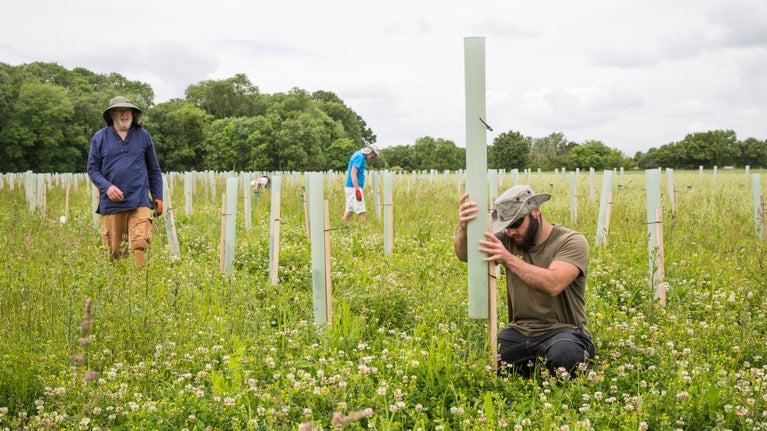
Tackling climate change
Uncover how we’re responding to the changing climate at places in our care.

We're working in a range of ways to make the places in our care more sustainable, including using heat pumps to harness the heat from the ground below our feet. Heat pumps are not only better for the environment, they are better for fragile collections too.
A heat pump is a device that uses a small amount of energy, in the form of electricity, to move heat from one location (the ground, the air or water) to another, such as a building. The heat is then amplified with compressors and passed through something called a heat exchanger. From there it’s taken to an underfloor or radiator heating system.
The low temperature background heat provided by heat pumps is much better for the sensitive collections at places in our care, rather than the fluctuating high temperatures from a fossil fuel boiler.
When the house at Croome was re-serviced, a new ground-source heating system was installed, reducing the site's reliance on fossil fuels. For every unit of electricity used by the system, around 4.5 units of heat is provided back into the house.
Croome has a large ‘ground-loop’: a network of pipes approximately 6kms long, under an area of the south park. These pipes are filled with a mixture of water and antifreeze which absorbs the heat from the ground as it is circulated around the system.

The ground-source heat pump at Wimpole has reduced the estate's carbon emissions by 58 tonnes per year. The system, which was installed in 2018, uses a small amount of electricity to move heat from the ground to the mansion and café at Wimpole, where it is then passed through a heat exchanger to heat these spaces.
Find out more about combating climate change at Wimpole
Powis Castle is now in the enviable position of generating more energy than it uses, after installing a range of renewable energy systems. The castle's restored glasshouses, which date back to before 1900, are lit by energy generated from solar panels and heated by a ground-source heat pump. The pump produces 90 per cent of the heat needed for the garden's nursery, and the improved air distribution inside is much better for plant health too.
Our renewable energy projects reduce our dependence on fossil fuels and our impact on climate change. What's more, the money we save by being more energy efficient goes towards vital conservation work that protects the countryside and the wildlife that depends on it.
This ensures that the special places in our care will remain beautiful and full of life for future generations to enjoy.

Uncover how we’re responding to the changing climate at places in our care.
Discover which of the places in our care generate their own hydroelectricity, from a 19th-century 'smart home' in Northumberland to a state-of-the-art water turbine in scenic Snowdonia.

Discover how some of the special places in our care are harnessing the power of the sun to generate electricity and reduce their carbon footprints.

From tips on saving water to combatting plastic pollution, learn more about our work to protect precious coasts and rivers for wildlife and people, and what you can do to help.

Discover more about the National Trust’s role at COP26 in Glasgow and how you can help tackle the climate crisis.

With support from the Government’s Green Recovery Challenge Fund, we're looking for ways to protect our environment and combat climate change. Find out more about the work we're doing.

Discover how biomass boilers are being used by some of the special places in our care to provide heat and hot water whilst also reducing their carbon footprint.
